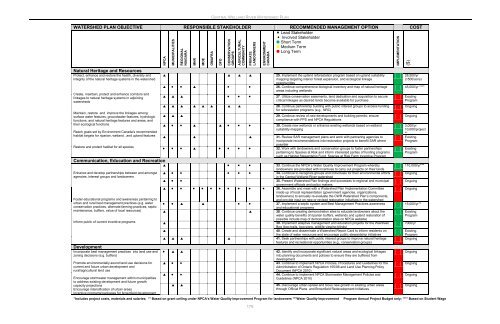Central Welland River Watershed Plan - Niagara Peninsula ...
Central Welland River Watershed Plan - Niagara Peninsula ...
Central Welland River Watershed Plan - Niagara Peninsula ...
- No tags were found...
Create successful ePaper yourself
Turn your PDF publications into a flip-book with our unique Google optimized e-Paper software.
NPCAMUNICIPALITIESREGIONALNIAGARAMNRMOECENTRAL WELLAND RIVER WATERSHED PLANWATERSHED PLAN OBJECTIVE RESPONSIBLE STAKEHOLDER RECOMMENDED MANAGEMENT OPTION COST Lead Stakeholder• Involved Stakeholder• Short Term• Medium Term• Long TermNatural Heritage and ResourcesProtect, enhance and restore the health, diversity andintegrity of the natural heritage systems in the watershedCreate, maintain, protect and enhance corridors andlinkages to natural heritage systems in adjoiningwatershedsMaintain, restore and improve the linkages amongsurface water features, groundwater features, hydrologicfunctions, and natural heritage features and areas, andtheir ecological functionsReach goals set by Environment Canada‟s recommendedhabitat targets for riparian, wetland , and upland featuresRestore and protect habitat for all speciesCommunication, Education and RecreationEnhance and develop partnerships between and amongstagencies, interest groups and landownersFoster educational programs and awareness pertaining tourban and rural best management practices (e.g. waterconservation practices, alternate farming practices, septicmaintenance, buffers, value of local resources)Inform public of current incentive programsDevelopmentIncorporate best management practices into land use andzoning decisions (e.g. buffers)Promote environmentally-sound land use decisions forcurrent and future urban development andrural/agricultural land useEncourage stormwater management within municipalitiesto address existing development and future growthcapacity projectionsEncourage intensification of urban areasIncentive programs/packages for brownfield development*Includes project costs, materials and salaries; ** Based on grant ceiling under NPCA’s Water Quality Improvement Program for landowners ***Water Quality ImprovementOMAFRADFOCONSERVATIONGROUPSAGRICULTURALCOMMUNITYPRIVATELANDOWNERS179ENVIRONMENTCANADA 25. Implement the upland reforestation program based on upland suitabilitymapping targeting interior forest expansion, and ecological linkageopportunities • • • • 26. Continue comprehensive biological inventory and map of natural heritageareas including wetlands • • • 27. Utilize conservation easements, land dedication and acquisition to securecritical linkages as desired lands become available for purchase 28. Continue partnership building with public interest groups to access fundingfor reforestation programs (e.g., NRC) 29. Continue review of new developments and building permits; ensurecompliance with PPS and NPCA Regulations • • • • • 30. Create new wetlands or enhance existing wetlands based on wetlandsuitability mapping 31. Review SAR management plans and work with partnering agencies toincorporate recommendations into restoration projects to benefit SAR wherepossible• • • • • • • 32. Work with landowners and conservation groups to foster partnershipspertaining to Species at Risk and inform interested parties of funding programssuch as Habitat Stewardship Fund, Species at Risk Farm Incentive Program • • • 33. Continue the NPCA‟s Water Quality Improvement Program wherebylandowners are provided with incentives to carry out projects on their lands • • • • • 34. Continue to recognize groups and individuals for their environmental effortsin the <strong>Central</strong> <strong>Welland</strong> <strong>River</strong> watershed • • 35. Present <strong>Watershed</strong> <strong>Plan</strong> findings and successes to regional and municipalgovernment officials and policy makers • • • • • • • • • • 36. Assemble and meet with a <strong>Watershed</strong> <strong>Plan</strong> Implementation Committeemade up of local representation (government agencies, organizations,landowners) to annually re-evaluate the CWR <strong>Watershed</strong> <strong>Plan</strong>‟s components,and provide input on new or revised restoration initiatives in the watershed• • • • 37. Implement a septic system and Best Management Practices awarenessand educational programs 38. Continue creating demonstration sites to educate landowners about thewater quality benefits of riparian buffers, wetlands and upland restoration (ifpossible include map of demonstration sites on NPCA website)39. Implement adaptive management and education projects for the WainfleetBog (bog trails, bog signs, wildlife viewing blinds)40. Create and disseminate a <strong>Watershed</strong> Report Card to inform residents onthe state of water resources and encourage public stewardship initiatives 41. Seek partnerships with public interest groups to improve natural heritagefeatures and recreational opportunities (e.g., conservation groups)• 42. Identify and incorporate significant natural areas and ecological linkagesinto planning documents and policies to ensure they are buffered fromdevelopment • • 43. Continue to implement NPCA Policies, Procedures and Guidelines for theAdministration of Ontario Regulation 155/06 and Land Use <strong>Plan</strong>ning PolicyDocument (NPCA 2010) • • 44. Continue to implement NPCA Stormwater Management Policies andGuidelines (NPCA 2010) 45. Discourage urban sprawl and focus new growth in existing urban areasthrough Official <strong>Plan</strong>s and Brownfield Redevelopment InitiativesProgram Annual Project Budget only; **** Based on Student WageIMPLEMENTATION($)28,500/yr(1500/acre)45,000/yr ****ExistingProgramOngoingOngoing3,000/yr10,000/project**ExistingProgramExistingProgram110,000/yr***OngoingOngoingOngoing15,000/yr**ExistingProgram7000/yrExistingProgramOngoingOngoingOngoingOngoingOngoing
















